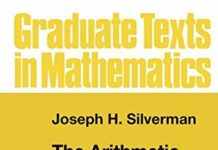
Ebook Info
- Published: 1994
- Number of pages: 541 pages
- Format: PDF
- File Size: 29.68 MB
- Authors: Joseph H. Silverman
Description
In the introduction to the first volume of The Arithmetic of Elliptic Curves (Springer-Verlag, 1986), I observed that “the theory of elliptic curves is rich, varied, and amazingly vast,” and as a consequence, “many important topics had to be omitted.” I included a brief introduction to ten additional topics as an appendix to the first volume, with the tacit understanding that eventually there might be a second volume containing the details. You are now holding that second volume. it turned out that even those ten topics would not fit Unfortunately, into a single book, so I was forced to make some choices. The following material is covered in this book: I. Elliptic and modular functions for the full modular group. II. Elliptic curves with complex multiplication. III. Elliptic surfaces and specialization theorems. IV. Neron models, Kodaira-Neron classification of special fibers, Tate’s algorithm, and Ogg’s conductor-discriminant formula. V. Tate’s theory of q-curves over p-adic fields. VI. Neron’s theory of canonical local height functions.
User’s Reviews
Editorial Reviews: Review .,.”this book deserves to be as popular as its forerunner and a great many people will be looking forward to reading a third volume.” – Monatshefte fA1/4r Mathematik…”this book deserves to be as popular as its forerunner and a great many people will be looking forward to reading a third volume.” – Monatshefte fr Mathematik
Reviews from Amazon users which were colected at the time this book was published on the website:
⭐This book is a continuation of the authors earlier book on elliptic curves, which was also an excellent book, and treats the more specialized topics in elliptic curves. I cannot think of a branch of physics or engineering that has not made use of some facet of the theory of elliptic curves, and they have myriads of applications in other fields also, such as cryptography and financial engineering. The book is very organized, straightforward to read, the author summarizes well his intentions at the beginning of each chapter, and recommends several references for topics left out of the main discussion. Space does not allow a detailed chapter by chapter review, so I will confine my review to the first two chapters, which were of main interest to me. In summary, Chapter 1 discusses how to study elliptic curves by taking a collection of them, each member being isomorphic, and studying the properties of modular functions and differential forms on this collection, now thought of as an algebraic curve, called the moduli space. The famous linear operators, called the Hecke operators, act on the the space of modular forms, and they and their eigenfunctions satisfy the same set of relations. One then attaches the well-known L-series to the modular forms that has very interesting algebraic and analytic properties. In more detail, the author does the following in the chapter. The set of lattices in the complex plane modulo non-zero multiplication L/C* is considered, along with the set of elliptic curves over the complex plane modulo complex isomorphism. These collections are proven to be bijective by showing that L/C* is isomorphic to C by first putting a complex structure on it. This leads to a surjective map from the upper-half plane H to L/C*. Proving this to be injective leads to a bijection from SL2(Z)H to L/C*. Since the matrix -1 acts trivially on H, one can quotient out +1 and -1 and obtain the modular group. The quotient space modular groupH is a 2-sphere minus a point, but can be made into a Riemann surface by extending the upper half-plane (called H*). The modular curve X(1) = modular groupH* results and is compact and Hausdorff. A complex structure is put on it, making it into a a Riemann surface of genus 0. Meromorphic functions on X(1) are rational functions of the j function, but more interesting functions are defined on X(1), namely the modular functions, such as the Eisenstein series. These considerations lead to a proof of the uniformization theorem for elliptic curves over C. For a given elliptic curve E, a study of the set of all isogenies to E of degree n is the same as that of studying degree n maps from E to other elliptic curves, which is called the dual isogeny, and leads to the Hecke operator. The Hecke operator and the homothety operator both map the divisor group of the lattice to itself, and generate a commutative algebra, called the Hecke algebra. Hecke operators can act on modular forms of weight 2k, and modular forms exist which are simultaneous eigenfunctions for the Hecke operator of weight 2k. It can be proven, but the author does not do so, that the normalized eigenfunctions form a basis for the space of cusp forms of weight 2k. The Fourier coefficients of the eigenfunction have an Euler product decomposition of a Dirichlet series attached to f, called the L-series. In the next chapter, the author considers elliptic curves that have extra endomorphisms, called complex multiplication. The collection of endomorphisms is usually taken to be the real numbers R, or R(K), which is the ring of integers of R tensored with the rational numbers. And, just as in chapter 1, he studies collections of elliptic curves, but here ones with the same endomorphism ring., called ELL(R) in the book. Asking the question of how to construct an elliptic curve with complex multiplication by a particular R(K) leads him to studying the ideal class group of R(K), and this group is shown to act transitively on ELL(R(K)). The author also shows that every elliptic curve with complex multiplication is defined over an algebraic extension of Q. Several interesting examples of ellipti curves with complex multiplication are given. After a brief review of class field theory, the author proves that K(j(E)) is the Hilbert class field H and shows how the Galois group of H/K acts on j(E). The torsion points of E are then used to generate abelian extensions of K, using the Weber function for E/H, thus generalizing the usual cyclotomic extensions of number theory. Very interesting examples are given of these constructions and it is also shown that j(E) is an algebraic integer. Then after a brief review of cyclotomic class field theory, the author proves what he calls the main theorem of complex multiplication, which says that an automorphism of the torsion subgroup is essentially analytic multiplication by an idele of K. This theorem allows one to define a Grossencharacter associated to an elliptic curve with complex multiplication. For such a curve one can then define an L-series and show that it can be expressed as a Hecke L-series with Grossencharacter.
⭐Pleased with book
⭐
Keywords
Free Download Advanced Topics in the Arithmetic of Elliptic Curves (Graduate Texts in Mathematics, 151) in PDF format
Advanced Topics in the Arithmetic of Elliptic Curves (Graduate Texts in Mathematics, 151) PDF Free Download
Download Advanced Topics in the Arithmetic of Elliptic Curves (Graduate Texts in Mathematics, 151) 1994 PDF Free
Advanced Topics in the Arithmetic of Elliptic Curves (Graduate Texts in Mathematics, 151) 1994 PDF Free Download
Download Advanced Topics in the Arithmetic of Elliptic Curves (Graduate Texts in Mathematics, 151) PDF
Free Download Ebook Advanced Topics in the Arithmetic of Elliptic Curves (Graduate Texts in Mathematics, 151)




